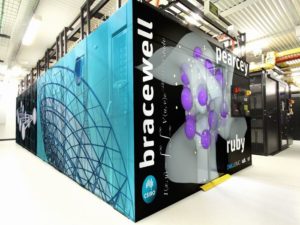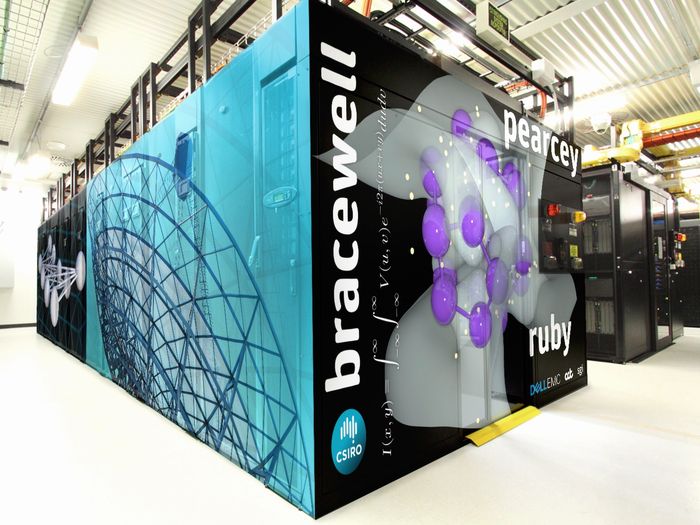 Today CSIRO, Australia’s top science agency, announced deployment of a new Dell EMC supercomputer, kicking off a new generation of research in artificial intelligence.
Today CSIRO, Australia’s top science agency, announced deployment of a new Dell EMC supercomputer, kicking off a new generation of research in artificial intelligence.
This new system will provide greater scale and processing power we need to build our computer vision systems by optimization of processing over broader scenarios, represented by much larger sets of images, to help train the software to understand and represent the world. We’ll be able to take our computer vision research to the next level, solving problems through leveraging large scale image data that most labs around the world aren’t able to.” Assoc. Professor Barnes said.
The new system is named ‘Bracewell’ after Ronald N. Bracewell, an Australian astronomer and engineer who worked in the CSIRO Radiophysics Laboratory during World War II, and whose work led to fundamental advances in medical imaging.
In addition to artificial intelligence, the system provides capability for research in areas as diverse as virtual screening for therapeutic treatments, traffic and logistics optimization, modelling of new material structures and compositions, machine learning for image recognition and pattern analysis.
CSIRO requested tenders in November 2016 to build the new system with a $4 million budget, and following Dell EMC’s successful proposal, the new system was installed in just five days across May and June 2017. The system is now live and began production in early July 2017.
Greater scale and processing power enables richer, more realistic vision solution
One of the first research teams to benefit from the new processing power will be Data61’s Computer Vision group, led by Associate Professor Nick Barnes. His team develops the software for a bionic vision solution that aims to restore sight for those with profound vision loss, through new computer vision processing that uses large scale image datasets to optimize and learn more effective processing.
Bracewell will help the research team scale their software to tackle new and more advanced challenges, and deliver a richer and more robust visual experience for the profoundly vision impaired.
When we conducted our first human trial, participants had to be fully supervised and were mostly limited to the laboratory, but for our next trial we’re aiming to get participants out of the lab and into the real world, controlling the whole system themselves,” Assoc. Professor Barnes said.
With access to this new computing capability, Assoc. Professor Barnes and his team will be able to use much larger data sets to help train the software to recognize and process more images, helping deliver a greater contextual meaning to the recipient.
To make this a reality, we need to build vision processing systems that show accurate visualizations of the world in a broad variety of scenarios. These will enable people to the world through their bionic vision in a way that enables them to safely and effectively interact in challenging visual environments.” Assoc. Professor Barnes said.
Efficient installation speeds time to results
The Bracewell system is built on Dell EMC’s PowerEdge platform, with partner technology including GPUs for computation and InfiniBand networking, which pieces all the compute nodes together in a low latency and high bandwidth solution faster than traditional networking.
Dell EMC ANZ High Performance Computing Lead, Andrew Underwood, said the installation process was streamlined and optimized for deep learning applications, with Bright Cluster Manager technology helping put these frameworks in place faster than ever before.
Our system removes the complexity from the installation, management and use of artificial intelligence frameworks, and has enabled CSIRO to speed up its time to results for scientific outcomes, which will in turn boost Australia’s competitiveness in the global economy.” Mr. Underwood said.
The system includes:
- 114 x PowerEdge C4130 with NVIDIA Tesla P100 GPUs, NVLINK, dual Intel Xeon processors and 100Gbps Mellanox EDR InfiniBand
- 1,634,304 CUDA Compute Cores
- 3,192 Xeon Compute Cores
- 29TB RAM
- 13 x 100Gbps 36p EDR InfiniBand switch fabric
- Bright Cluster Manager Software 8.0
Doubling the aggregate computational power available to researchers
CSIRO Deputy Chief Information Officer, and Head of Scientific Computing, Angus Macoustra, said the system is crucial to the organization’s work in identifying and solving emerging science problems.
“This is a critical enabler for CSIRO science, engineering and innovation. As a leading global research organization, it’s important to sustain our global competitiveness by maintaining the currency and performance of our computing and data infrastructures,” Mr. Macoustra said.
The power of this new system is that it allows our researchers to tackle challenging workloads and ultimately enable CSIRO research to solve real-world issues. The system will nearly double the aggregate computational power available to CSIRO researchers, and will help transform the way we do scientific research and development,” Mr. Macoustra said.
Armughan Ahmad, senior vice president and general manager for Dell EMC Ready Solutions and Alliances said, “Dell EMC continues to be committed to creating technologies that drive human progress. This is particularly true of our high performance computing (HPC) Ready Solutions offerings, which are leveraged by leading research institutions like CSIRO The research performed at CSIRO will change the way we live and work in the future for the better. We’re proud to play a part in evolving the work happening at CSIRO and look forward to enabling scientific progress for years to come.”
The system builds on Dell EMC’s varied work in the high-performance computing space, with the Pearcey system installed in 2016 and numerous other systems for Australian universities such as the University of Melbourne ‘Spartan’, Monash University ‘MASSIVE3’ and the University of Sydney ‘Artemis’.




